Diseases of the brood
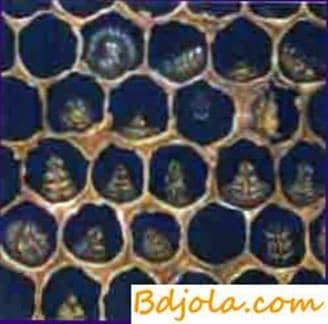
The foulbrood.
The term “foulbrood” refers to the infectious diseases of the brood of the bee family, accompanied by rotting in different stages of development. Diseases of all three bee colonies are affected, and the disease begins to develop in the larvae’s interior, which eventually turns into putrefactive mass. The color, smell and viscidity of this putrefactive mass are different.
Since foulbrood is one of the most dangerous diseases, which often inflict huge losses on apiaries, up to the complete destruction of the whole apiary, it is necessary to dwell on it in more detail.
Gnilets is a collective name for several infectious diseases of the bee family larvae. Although these diseases present a similar pattern in general outline, they are caused by various pathogens.
Gniltsovye diseases are characterized by the following common signs: the death of the brood both unprinted and printed; the scattered arrangement of the rotting larvae among the healthy brood and empty cells: on the same honeycomb, brood is present in various stages of development alternately, from the testicle to the fully formed individuals, which makes the honeycomb seem “motley”; pressed lids of rotting cells and their abnormally dark color; in some of the caps there are uneven (torn) openings; the gradual decay of the body of the larvae and their transformation into a sticky, and sometimes viscous, viscous, formless mass, which has an unpleasant, often disgusting, “putrefactive” smell, and, consequently, a gradual weakening of the bee family.
At present, the following species of foulbrood diseases are known: European foulbrood, called open foul broth; American foulbrood, or foulbrood of a printed brood; saccule brood; calcareous brood; stone brood.
European foulbrood.
The causative agent of European foulbrood is a microbe called bacterium
The causative agent of the disease, according to the research of Soviet scientists, is not stable. In water with heating to 50 њ perishes within 5 minutes. In distilled water at room temperature, it persists for 7-10 days, in sugar syrup for 16-20 days, in the bodies of dead larvae up to 5 months.
One-percent formalin solution, a 0.5% solution of potassium permanganate, a 2% solution of caustic sodium, a 3% solution of carbolic acid kill the microbe in 5 minutes. In a roaming 10% sugar syrup at room temperature, he can live for 21 days, and in honey – for a month. Dried at room temperature persists throughout the year.
Formaldehyde fumes proved to be fatal for the microbe. Therefore, it is recommended to use evaporation of 50 cc for disinfection. cm formalin per 1 cu. m volume of air at a temperature of 40 њ for 3 hours; 3-4% solutions of activated chloramine kill the causative agent of European foulbrood, located in the corpses of larvae and in perge, for 20 minutes. Additional feeding from sick families or carrying frames from them is one of the ways of transmission of infection.
The external signs of this disease are as follows. European foulbrood affects mainly open brood, and; namely – larvae of 3-4 days of age. Sometimes larvae of the older age also become shed. Ill larvae lose their mother-of-pearl color, take the most diverse position in the cells, but most often descend to its bottom, and acquire a yellowish color.
Then they become yellowish-gray or yellowish-brown and finally spread into an oily, or rather mushy, mass, at the beginning of the disease, which does not have a smell, and then emits a smell of rotten meat, less often – sour paste. As a result, small brown lumps turn into larvae with a silky reflection.
In neglected cases, this disease also causes the death of some of the sealed larvae, immediately after they are sealed (before the cocoon is spinning). Pupae with this species of foulbrood are not affected. Just as with American foulbrood, concave and perforated caps on a sealed brood are often observed. It is possible that they are gnawed by bees.
A distinctive feature of the European foulbrood is the yellow color of the larvae, and the dried mass in the cells in the form of crusts has a dark color. This mass does not adhere to the walls and the bottom of the cell, and therefore it can be easily extracted from there.
With this disease, the stickiness of the putrefactive mass is negligible. The dry putrefactive mass of the bee is hardly touched, and when it dries, they pull it out and the cell is cleaned. In strong families, such cell cleaning is much more successful than in weak ones.
The European foulbrood is not the same in its manifestations. Sometimes it develops very quickly and devastates entire apiaries. In other cases, this disease is not devastating, especially in years with good honey picking.
Infection of larvae occurs through food and begins with the destruction of the digestive system.
European foulbrood is more pronounced and produces in the apiaries of devastation in spring and early summer more than in other seasons. Often; in strong families, it completely disappears in late summer.
With the development in the corpses of larvae of other microbes, the external signs of foulbrood change, while the rotting mass produces a sharp putrefactive or acidic odor.
Although the disease subsides sometimes in strong families, but this does not mean that the apiary finally got rid of the foulbrood. The next year the disease can resume.
American foulbrood.
American foulbrood appears later than the European one and reaches its maximum development in the second half of the summer. The causative agent of this foulbrood is the sporiferous microbe, called bacillus.
This microbe affects larvae more adult than European foulbrood, namely, at the time when they reached maturity, they stopped eating and are ready to pupate; at this time the bees begin to seal them. Larvae usually die within 4 days of being sealed before the 5th moult, and therefore rotting corpses are in sealed cells. However, younger larvae are often affected.
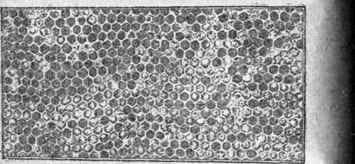
Fig. General view of brood affected by American foulbrood. Near the unsealed cells, sunken and holed cell caps are visible.
American foulbrood can manifest simultaneously with the European, so the picture of the disease can not be strictly monotonous.
External signs of the American foulbrood resemble other species of foulbrood: the same variegated species of honeycombs is the same scattered in the cells of brood in different stages of development, only the rotting mass of larvae is in sealed cells. The cells of the cells with diseased larvae are dark and sunken. Some of them are perforated.
The larvae are first colored in a light brown color, then darken, they acquire a milk chocolate and at the end are dark brown, even black in color. Characteristic in this disease are: a faint smell from honeycombs and rotting brood, slightly reminiscent of the smell of a hot solution of carpentry glue, and a high viscosity of putrefactive mass.
Pupae also die from this disease; they dry out on the underside of the cells, become sticky and acquire a characteristic smell and color. Often the pupa’s tongue sticks to the top of the cell and remains attached here even after the pupa has fallen off and turns into a crust.
The causative agent of the American foulbrood is able to form spores.
According to some reports, the spores of this microbe in dry material retain their viability up to 22 beds.
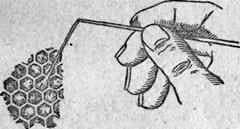
Fig. The viscidity of the putrid mass of the decayed larva, which died from American foulbrood.
Spores can withstand boiling in water (100 њ) up to 11 minutes; in honey they can die only by boiling for half an hour or more.
The dried spores die from direct sunlight within 28-41 hours, in honey – in 4-6 weeks, and in the darkness remain viable in honey for more than a year.
Disputes of the causative agent of the American foulbrood withstand disinfectants for a long time, for example, they for months remain viable in a 5% solution of carbolic acid; days in a 0.1% solution of the mercury; hours – in 10% and minutes – in a 20% solution of formalin. A 10% solution of caustic soda or laundry soda kills spores after 2-4 minutes.
The American foulbrood, like the European foulbrood, is brought to the apiary when buying bee colonies from disease-ridden apiaries, as well as catching “wandering” swarms; when the bees are fed with honey from the apiaries infected with foulbrood; when bees attack one bee on another, which is often the case with an incorrect arrangement of apiaries; during their travels, on bribes, etc.
Within the apiary, foulbrood extends during the wandering of bees, as well as during attack and bee stolen. Often the spread of infection is facilitated by the beekeeper, if he does not keep cleanliness in the apiary, seldom disinfects the instrument and uses it while working for all families of the apiary, feeds honey bees of unknown origin, transplanting bee colonies into unspecified hives, etc. Especially promotes the spread of foulbrood application techniques connected by an unsystematic permutation of honeycombs with brood, bees; and food from some bee colonies to others, since it was the honeycombs in which the diseased brood was excreted (although the disease was not noticed by the beekeeper), is the main source of infection. Such methods apply first of all: the reinforcement of some families at the expense of others, the formation of pre-fabricated layers, the equalization of bee colonies, as well as the autumn removal of the frames from all the apiary families into a “common heap” and staging them in the spring with the expansion of the nests indiscriminately as the families got. In apiaries where these methods are used, the introduced disease can spread very quickly. To eliminate it, it takes a lot of work and money.
In a bee family, larvae become infected with foulbrood when feeding. Usually this happens as follows. A small number of larvae are infected in a beehive infested with a beehive, in which the pathogen develops and leads them to death. Subsequently, young (beehive) bees clean cells of honeycombs, in which there were sick larvae and at the same time they strongly contaminate their oral parts with spores. Taking part in the feeding of many larvae, such bees infect them, since along with the food, fungus spores also enter the larvae.
Infected by American foulbrood, larvae do not get sick right away, as their body contains a large amount of sugars, which prevent spores from germinating. In the future, after the cocoon larvae spin, the percentage of sugar in the body of the larvae decreases, and the spores rapidly germinate, turn into microbes that multiply rapidly, and, spreading throughout the body), the larvae lead to death. The number of infected larvae, which subsequently perish, all the time; increases. The family is weakening, and if not taken, it may die. The disease quickly spreads to other families and, with belated adoption of preventive and curative measures, can destroy the entire apiary.
Sirloin brood.
This disease is not known for our beekeepers. However, there are already reports that it, although rarely, occurs in impotent years in our apiaries, and in rather severe forms.
Signs of this disease are as follows: brood (bee and drone) is killed almost always in a sealed condition, within three to four days after sealing. The dead pupae are very rare. The dead larvae lie stretched along the cells. Caps are more often perforated, have 1-2 holes and are later printed by bees.
The dead larva is flabby and slightly yellowish, more rarely grayish. However, its color soon turns into brown and, finally, almost black.
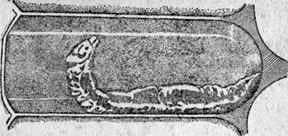
Fig. The crusts from the saccule brood take the form of a gondola.
When the internal organs of the larva are disintegrated, the body cover does not decompose and becomes rigid, causing the corpse of the larva to be removed intact. The saccule shell of dead larvae with a watery grainy content and served as an excuse for the name of the disease as a saccule brood. In the future, the dead larva shrinks into a gondola-shaped crust that does not adhere to the wall. The sows with the diseased brood do not smell, but the crushed corpse of the larva produces an unpleasant odor. The most recently infected larva are the most contagious. The period from infection to the appearance of the first signs of the disease is approximately 6 days.
The causative agent of the disease is a microbe of extremely small size, the so-called filtering virus.
The minimum temperature required to destroy this microbe, if maintained for 10 minutes is between 55 and 65 њ.
The causative agent remains viable and a 2% aqueous solution of carbolic acid for more than three weeks; 4% solution is more effective.
Control measures – the transfer of bees to a clean hive on an artificial wax. The presence of a good bribe is very conducive to the recovery of bee colonies. Unfavorable apiaries are subject to restrictive measures.
Calcareous brood (pericystismycosis).
This is a contagious brood disease that affects the main; image of drone larvae. The causative agent is a fungus, lime called pericystisapis. The fungus infects the larva before sealing, covering it and the entire cell with a white coating. The dead larvae harden and look like lime in appearance, hence the name – calcareous brood.
The disease easily passes after removal of affected brood and mold from hives, as well as with improved conditions of bees.
Stone brood (aspergillosis).
This is also a fungal disease that affects the pupa of the pupa, as well as adult bees. It is caused by mold fungus. Fungus bees bring bees with perga. Ill larvae or bees are covered with a brownish-green coating and die, and then turn into solid lumps, similar to pebbles. Bees, covered with mold, become shaggy. Spores of the fungus are harmful to humans. When they get into a mucous membrane, they cause irritation of the respiratory tract. Therefore, when working with patients in families, it is necessary to protect the nose and mouth with a moist gauze dressing. For the elimination of aspergillosis, it is recommended to remove the honeycomb-prone honeycomb, replace the hive and provide bees with good food. In cases of severe damage, the so-called distillation of bees is produced. Limestone, as well as stone brood, is a rare phenomenon in our country.
Measures against infectious diseases of brood.
Determination of foulbrood diseases is based on the nature of the changes of the brood affected by the disease, as well as by a laboratory study of brood affected by foulbrood. To do this, it is necessary to cut out a honeycomb pattern with brood size 10 X 15 cm and send it to the veterinary laboratory. The honeycomb should be packed in a box of the appropriate size, having placed on both sides of its wooden bars so that the honeycomb does not touch the bottom and the lid of the box. Simultaneously with the sample cell, you need to send a cover letter, in which you must indicate the signs of the disease, the number of affected families and the address of the apiary.
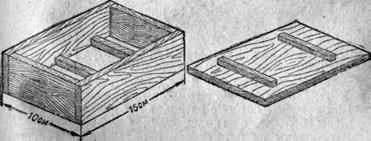
Fig. A box for sending samples of cells to the laboratory.
Preventive action.
It must be remembered that foulbroods, like other diseases, are much easier to prevent than to treat later. Therefore, the following precautionary measures must be taken:
1.Sorzhat strong families, always well provided with feed,
2. Keep hives with bees, frames, feeders, knives and other accessories of beekeeping clean, and spare honeycombs to be fumigated with sulfur or formalin.
3. Keep the spring and autumn of the family with good warming.
4. Do not allow dirty ponds near the apiary. It is necessary to have clean drinkers for bees.
5. Do not feed bees to a commercial, unknown source of honey, since it can be infected with foulbrood.
6. Do not use used hives and other accessories from apiaries that are unfit for rotting diseases, without preliminary thorough disinfection (disinfection).
7. Do not make prolonged inspections of bee colonies on cold days so as not to catch brood.
8. When buying bees you need to be very careful not to get sick bees.
9. Be always attentive when inspecting the hives, to notice the disease at the very beginning and that by transferring the queens or frames with the brood from one beehive to another do not spread the disease. This is one of the most important rules |
10.Zakrepit honeycomb frames for bee families.
Measures to combat foulbrood diseases.
These measures are based on the application of sanitary and medical measures to affected families.
Sanitary measures are the separation of sick families from healthy ones and the thorough disinfection of all care items and materials in contact with sick families. These measures are carried out by isolating sick families from the apiary and removing the affected brood from them.
When foulbroods are identified on large apiaries with several branches, sick families gather in one of the most remote from other apiaries of the departments, where all recreational activities are carried out.
The method of isolation of sick families is a rational measure, which deserves special attention. Isolation of sick families should, as a rule, be no closer than 4 km.
Before proceeding with sanitary and medical measures, it is necessary to carry out preparatory work in apiaries: to store enough medicines, disinfectants, sugar, artificial wax. Inspect all the families of the apiary, identify the sick and prepare them; to designate families from which fetal uteri will be taken to replace the old queens of sick families, to prepare the required number of new or carefully disinfected old hives, frames, ceilings, linen, insulation material, etc. To disinfect all property, it is necessary to equip or prepare a place inaccessible for bees.
In accordance with the existing regulations on the control of diseases and pests of bees, families affected by American foulbrood and a neglected form of European foulbrood are subjected to distillation followed by treatment with sodium norsulfazole. Running, bees are carried out in several ways. Of these, double distillation and fasting with starvation were significantly spread. Double distillation of bees is produced in the treatment of American foulbrood. In doing so, proceed as follows. The hive with the sick family is moved to the side, and another, new or disinfected hive is put in its place. Before this beehive, the bees are shaken off on a sheet of newsprint. Uterus before distillation of bees put in a box, which is placed between the frames with strips of artificial wax in a new hive. After 1-2 days a secondary distillation is carried out into a permanent hive on frames with full sheets of artificial wax, and bees are fed. At this time, the old uterus is replaced with another, taken from a healthy family, and the hive is insulated.
In the case of fasting with starvation, bees from the hive, where the sick family was, are first placed in a rover or a box where the uterus is transferred to the cell. The bees stand for 1-2 days in a cool place, and then they are distilled into a permanent disinfected hive on strips of an artificial honeycomb and replace the uterus. After 5-7 days, the overtaken family is framed with whole sheets of artificial wax.
Recently, the distillation of bees-with starvation is widely used not recommended, since it is found that fasting does not kill microbes, but at the same time greatly weakens the bees.
Single, or simple distillation is practiced in the treatment of bee colonies, sick with European foulbrood. It is made much simpler: the bees are distilled only once, onto entire sheets of an artificial honeycomb, and follow the same rules as in a double haul. Distilled families provide sugar syrup.
From the frame with the brood of sick families are prefabricated families, which give the queen in the brushes and feed stock. Such families are subjected to distillation after 21 days. Prefabricated rotten families put in a closed room or placed in the shade under the trees or appearing canopies at a distance of 4 km from the apiary. Flags of such families should be reduced. Arrival boards and walls of hives of these families are recommended to spray a 5-percent solution of phenol. This prevents theft, and, therefore, reduces the possibility of the spread of foulbrood.
For feeding bees, prepare a medical sugar syrup with sodium norsulfazole. Norsulfazole sodium (sulfatiazol sodium) is given in a dose of 0.3 g per 1 liter of syrup, made up of one part of the water and one part of the sugar, and it is fed in 3-9 doses every 7 days, 0.5-1 liters per one family.
Before adding norsulfazole to the syrup, sodium is dissolved in a glass of hot water. The medicinal feed is distributed to bees in feeders or disinfected honeycombs at the end of the day.
Bees can be distilled only if there is at least a small bribe in nature. In order to avoid attack, this operation is better spent in the evening.
Disturbances justify themselves when applying them to the main honey collector, since the families distilled after the honey collection do not provide themselves with honey and they need to be fed for the winter.
When foulbrood is found in autumn, sick families move to honey combs from obviously healthy families.
In carrying out measures to combat foulbrood, special attention should be given to improving the conditions of bees, namely: keep only strong families in the apiaries, provide them with benign food and in sufficient quantity, warm the nests well, keep the bees in good hives on properly built and light honeycombs, to place apiaries in the best places for honey; to produce sowing of honey plants on the apparel patches and to transport the bees to the nomadic migratory crops.
For the treatment of rotten diseases, new medicinal preparations have been proposed.
Apply for the treatment of European foulbrood a new antibiotic substance – sanazine, which had a good therapeutic effect. The experience of treatment was put on a large number of patients with foulings of apiaries. The best results were obtained when feeding bees to sick families with 1-1.5 liters of sugar syrup with sanazine (0.1-0.2 g per 1 liter of syrup), 3 to 6 times, with intervals between feedings of 6-7 days.
Treatment with sanazine is performed without distillation of bees while observing sanitary and zoogeogenic conditions of their maintenance.
Disinfection.
In the fight against foulbrood, it is essential to eliminate the source of contamination by disinfecting equipment and items of care.
Beehives, frames and other wooden objects with which bees of sick families were in contact are disinfected by the fire of a soldering lamp or other types of fire disinfection to light baking. Cells with honey after distillation of families are freed from honey and are re-heated to wax.
In European foulbrood, hives and suitable light honeycombs are recommended to be disinfected with a 3-5% activated aqueous solution of chloramine, prepared by adding a solution of chloram ammonium chloride (ammonia) in the same concentration to the chloramine solution.
The metal inventory is disinfected by calcination on fire. Roevni and canvas are disinfected by boiling in a 2% solution of liquor for 30 minutes. The honey extractors are washed with water and then hot with a 2-3% solution of liquor, and again washed with water.
Honey from rotten families is contagious for bees, it should be kept in a place inaccessible to bees before frost, and then realized for food purposes. Wax from dysfunctional on decay fowls goes to the waxing points marked “rotten”. It is not allowed to apply solar wax on the rotting apiaries. The apiary is considered free from foulbrood and the restrictions are removed after one year after the elimination of the disease.
Chilled brood.
Chilled brood is an infectious disease in which larvae and pupae die because of the cooling of the nests of the bee colonies. Disease is observed mainly in spring in weak families, contained in poorly insulated hives. In this case the brood dies in solid areas, mainly on the extreme honeycomb nests or at the bottom of the honeycomb frame. The chilled, unprinted brood darkens. The color of the frozen printed larvae is grayish, later it turns into dark brown. Control measures are prophylactic: the maintenance of strong, well-fed families and proper insulation of nests.
Other brood diseases (frozen seeding, dry seeding, dead brood) are relatively rare.
Diseases of the brood
